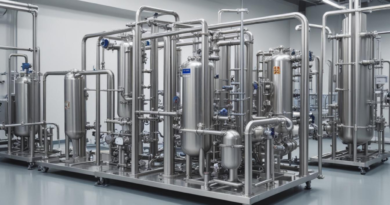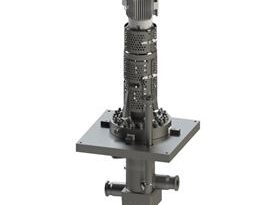energy efficient pump systems
Pump systems are integral components in a wide array of industries, facilitating the movement of fluids through various processes. These systems consist of several key elements, each playing a pivotal role in ensuring efficient and reliable operation. At the core, a typical pump system includes the pump unit, which imparts energy to the fluid, and the motor that drives the pump. Additionally, essential components such as valves, pipes, and control systems work in tandem to regulate flow rates and maintain system integrity.
There are numerous applications for pump systems across different sectors:
- Water Supply and Treatment: Ensuring consistent water delivery and processing for municipal and industrial use.
- Oil and Gas: Facilitating the extraction, transportation, and refining of petroleum products.
- Manufacturing: Enabling processes that require precise fluid handling and transfer.
- Agriculture: Supporting irrigation systems and the distribution of nutrients.
Understanding the various types of pump systems is crucial for selecting the right solution for specific applications. The primary categories include:
- Centrifugal Pumps: Utilize rotational energy to move fluids, ideal for low-viscosity liquids.
- Positive Displacement Pumps: Trap and transport a fixed volume of fluid, suitable for high-viscosity applications.
- Submersible Pumps: Designed to operate underwater, commonly used in wastewater management and dewatering.
- Diaphragm Pumps: Employ a diaphragm to displace fluid, often used for corrosive or abrasive liquids.
The efficiency of pump systems is a critical consideration, impacting both operational performance and cost savings. Factors such as pump selection, system design, and operational practices contribute to the overall energy efficiency. Implementing advanced technologies and adhering to best practices can significantly enhance the performance and longevity of pump systems.
To illustrate the components and their interactions within a pump system, consider the following table:
| Component | Function |
|---|---|
| Pump Unit | Provides the mechanical energy to move the fluid. |
| Motor | Drives the pump unit, converting electrical energy into mechanical motion. |
| Valves | Control the direction and flow rate of the fluid. |
| Pipes | Convey the fluid between different components of the system. |
| Control Systems | Monitor and regulate system parameters for optimal performance. |
In summary, pump systems are versatile and essential for numerous industrial and commercial applications. A comprehensive understanding of their components, types, and operational dynamics is fundamental to achieving high energy efficiency and realizing significant cost savings.
benefits of energy efficiency
Enhancing the energy efficiency of pump systems offers a multitude of advantages that extend beyond mere operational savings. One of the most significant benefits is the substantial cost savings realized through reduced energy consumption. Efficient pump systems consume less electricity, directly lowering utility bills and improving the overall financial performance of operations.
Moreover, energy-efficient pumps contribute to a smaller environmental footprint. By decreasing energy usage, these systems help reduce greenhouse gas emissions and other pollutants associated with power generation. This not only supports sustainability initiatives but also aligns with increasingly stringent environmental regulations.
Another key advantage is the extended lifespan of pump equipment. Operating at optimal energy levels minimizes wear and tear on mechanical components, reducing the frequency and cost of maintenance and replacements. This reliability ensures consistent performance and decreases downtime, which is critical for maintaining uninterrupted operations in industrial settings.
Improved system performance is also a notable benefit. Energy-efficient pumps often feature advanced technologies such as variable frequency drives (VFDs) and intelligent control systems that allow for precise flow and pressure management. This precision enhances the overall functionality of the pump system, ensuring that it meets specific operational requirements more effectively.
Compliance with regulatory standards is increasingly important in many industries. Implementing energy-efficient pump systems helps organizations adhere to energy consumption guidelines and environmental regulations, avoiding potential fines and enhancing corporate reputation.
To summarize, the benefits of prioritizing energy efficiency in pump systems include:
- Cost Savings: Lower energy bills and reduced operational costs.
- Environmental Impact: Reduced emissions and support for sustainability goals.
- Extended Equipment Lifespan: Less wear and tear, resulting in longer-lasting machinery.
- Enhanced System Performance: Improved control and precision in fluid handling.
- Regulatory Compliance: Meeting environmental and energy usage standards.
These advantages collectively contribute to more efficient, sustainable, and economically viable operations, highlighting the critical importance of energy efficiency in modern pump systems.
| Benefit | Description |
|---|---|
| Cost Savings | Reduction in energy consumption leads to lower utility expenses. |
| Environmental Impact | Decreased energy usage results in fewer emissions and supports sustainability. |
| Extended Equipment Lifespan | Optimized operation reduces mechanical stress, prolonging the life of pump components. |
| Enhanced System Performance | Advanced technologies enable precise control, improving overall system efficiency. |
| Regulatory Compliance | Adherence to energy and environmental standards helps avoid legal penalties. |
Investing in energy-efficient pump systems not only drives financial and operational benefits but also supports broader environmental and regulatory objectives, making it a strategic choice for organizations aiming for long-term sustainability and efficiency.
types of energy efficient pumps
Energy-efficient pump systems incorporate various technologies and designs to minimize energy consumption while maintaining optimal performance. Among the most notable types are:
- Variable Speed Pumps: Equipped with variable frequency drives (VFDs), these pumps adjust their operating speed based on real-time demand. This adaptability ensures that energy is not wasted during periods of low demand, resulting in significant cost savings and enhanced energy efficiency.
- High-Efficiency Centrifugal Pumps: Designed with optimized impeller and volute geometries, these pumps reduce hydraulic losses and improve flow characteristics. Their streamlined design minimizes turbulence and energy consumption, making them ideal for applications requiring consistent flow rates.
- Magnetic Drive Pumps: Utilizing a magnetic coupling between the motor and the pump, these systems eliminate the need for traditional seals. This not only reduces maintenance requirements but also enhances energy efficiency by minimizing mechanical losses.
- Solar-Powered Pumps: Harnessing renewable energy from the sun, these pumps are particularly suitable for remote or off-grid applications. By converting solar energy directly into mechanical energy, they offer a sustainable and energy-efficient solution with lower operational costs over time.
- Dual-Stage Pumps: Featuring two impellers in series, dual-stage pumps provide higher head pressures without a significant increase in energy consumption. This design effectively doubles the pressure output while maintaining efficient energy use.
- Intelligent Pump Systems: Integrated with advanced sensors and control algorithms, intelligent pump systems continuously monitor and adjust their operation for optimal performance. These systems can respond dynamically to changing conditions, ensuring maximum energy efficiency and reduced energy waste.
To better understand the differences and applications of these energy-efficient pump types, the following table provides a comparison:
| Type of Pump | Key Features | Applications | Energy Efficiency Benefits |
|---|---|---|---|
| Variable Speed Pumps | Adjustable motor speed via VFDs | HVAC systems, water treatment, irrigation | Reduces energy use during low demand, lowers operational costs |
| High-Efficiency Centrifugal Pumps | Optimized impeller and volute design | Consistent flow rate applications, industrial processes | Minimizes hydraulic losses, enhances flow efficiency |
| Magnetic Drive Pumps | Magnetic coupling, no mechanical seals | Corrosive or hazardous fluids, chemical processing | Reduces mechanical losses, lowers maintenance energy costs |
| Solar-Powered Pumps | Solar panels integrated, renewable energy source | Remote water supply, agricultural irrigation | Utilizes free solar energy, decreases dependency on grid power |
| Dual-Stage Pumps | Two impellers in series for higher pressure | High-pressure applications, municipal water systems | Increases pressure output without proportionate energy increase |
| Intelligent Pump Systems | Advanced sensors and control algorithms | Smart buildings, automated industrial processes | Optimizes operation dynamically, minimizes energy waste |
Selecting the appropriate type of energy-efficient pump depends on the specific requirements of the application, including flow rate, pressure, fluid properties, and environmental conditions. By carefully evaluating these factors and choosing the right pump technology, organizations can achieve significant energy efficiency improvements and realize substantial cost savings over the pump system’s lifecycle.
installation best practices
 Proper installation of pump systems is crucial to maximizing their energy efficiency and ensuring long-term cost savings. Adhering to best practices during the installation phase can prevent common issues that lead to inefficiencies and increased operational costs. The following guidelines provide a comprehensive approach to installing energy-efficient pump systems effectively:
Proper installation of pump systems is crucial to maximizing their energy efficiency and ensuring long-term cost savings. Adhering to best practices during the installation phase can prevent common issues that lead to inefficiencies and increased operational costs. The following guidelines provide a comprehensive approach to installing energy-efficient pump systems effectively:
1. Accurate Pump Sizing and Selection
Selecting the appropriate pump size is fundamental to achieving optimal performance and energy efficiency. Oversized pumps can lead to excessive energy consumption, while undersized pumps may fail to meet the required flow rates and pressures.
- Conduct a Detailed System Analysis: Assess the specific requirements of the application, including flow rates, head pressure, and fluid characteristics.
- Use Pump Curves: Refer to manufacturer-provided pump curves to match the pump performance with system demands.
- Consider Future Expansion: Account for potential increases in demand to avoid frequent replacements or upgrades.
2. Optimal Placement and Foundation
The physical placement of the pump system significantly impacts its performance and energy consumption.
- Stable Foundation: Ensure that the pump is mounted on a rigid and level foundation to minimize vibrations and mechanical stress.
- Accessibility: Position the pump in an area that allows easy access for maintenance and inspections, reducing downtime and maintenance costs.
- Avoid Extreme Conditions: Install the pump in environments protected from extreme temperatures, moisture, and corrosive substances to enhance longevity and efficiency.
3. Efficient Piping and Hydraulics
Proper piping layout and hydraulic design are essential for minimizing energy losses within the system.
- Minimize Pipe Length: Shorter pipe runs reduce friction losses, which in turn lowers the required pump head and energy consumption.
- Use Appropriate Pipe Materials: Select materials that offer low friction coefficients and are compatible with the fluid being pumped to enhance flow efficiency.
- Implement Proper Valving: Install valves and fittings that allow for smooth flow transitions and reduce turbulence, thereby improving overall system efficiency.
4. Electrical Considerations
Ensuring that the electrical setup is compatible with the pump system is vital for safe and efficient operation.
- Correct Electrical Supply: Verify that the power supply matches the pump’s voltage and frequency specifications to prevent electrical inefficiencies or damage.
- Use Energy-Efficient Motors: Select motors with high-efficiency ratings and consider variable frequency drives (VFDs) to adjust motor speed based on demand, further enhancing energy savings.
- Implement Proper Wiring and Protection: Use appropriately sized conductors and install protective devices such as circuit breakers and fuses to safeguard the system against electrical faults.
5. Integration of Control Systems
Advanced control systems play a pivotal role in maintaining energy-efficient pump operations.
- Automated Controls: Integrate programmable logic controllers (PLCs) or other automated systems to regulate pump speed, pressure, and flow based on real-time data.
- Monitoring and Feedback: Implement sensors and monitoring tools to continuously assess system performance and make adjustments that optimize energy use.
- Remote Accessibility: Utilize remote monitoring solutions to manage pump operations efficiently, allowing for timely interventions and adjustments.
6. Comprehensive Commissioning Procedures
Thorough commissioning ensures that the pump system operates as intended from the outset.
- Pre-Installation Testing: Test individual components before full system integration to identify and rectify potential issues early.
- Systematic Startup: Follow a step-by-step startup procedure to gradually introduce the pump into the system, monitoring for any irregularities.
- Performance Verification: Compare the actual performance against the design specifications to confirm that the system meets the required energy efficiency and operational parameters.
7. Training and Documentation
Proper training and comprehensive documentation support ongoing energy-efficient operations and maintenance.
- Staff Training: Ensure that personnel are well-trained in operating and maintaining the pump system to prevent operational errors that could compromise efficiency.
- Maintain Detailed Records: Keep thorough documentation of installation procedures, system configurations, and maintenance activities to facilitate troubleshooting and future upgrades.
- Provide User Manuals: Supply detailed user manuals and guidelines to assist operators in understanding the system’s functionalities and best practices for energy-efficient operation.
Implementing these installation best practices not only enhances the energy efficiency of pump systems but also contributes to significant cost savings through reduced energy consumption and lower maintenance requirements. A meticulously installed pump system ensures reliable performance, extends equipment lifespan, and supports sustainable operational goals.
To summarize key installation best practices:
| Best Practice | Description |
|---|---|
| Pump Sizing and Selection | Accurate matching of pump capacity to system requirements to avoid energy waste. |
| Optimal Placement | Stable and accessible installation sites to reduce vibrations and facilitate maintenance. |
| Piping and Hydraulics | Efficient layout and materials to minimize friction and energy losses. |
| Electrical Setup | Proper electrical specifications and energy-efficient motor integration. |
| Control Systems Integration | Advanced automation for dynamic energy management and system optimization. |
| Commissioning Procedures | Comprehensive testing and performance verification to ensure system efficiency. |
| Training and Documentation | Educated personnel and detailed records to maintain and optimize pump operations. |
By following these best practices, organizations can ensure that their pump systems operate at peak energy efficiency, resulting in ongoing cost savings and enhanced operational sustainability.
maintenance and optimization
Effective maintenance and optimization are pivotal in ensuring that pump systems operate at peak energy efficiency while minimizing cost savings through reduced downtime and extended equipment lifespan. A strategic approach to maintenance not only preserves the functionality of the pump system but also enhances its performance over time. The following comprehensive practices are essential for maintaining and optimizing energy-efficient pump systems:
1. Regular Maintenance Practices
Consistent maintenance is the foundation of reliable and efficient pump system operation. Key activities include:
- Component Inspection: Periodically examine critical parts such as impellers, seals, and bearings for signs of wear, corrosion, or damage. Early detection of issues can prevent costly repairs and energy losses.
- Lubrication Schedules: Adhere to recommended lubrication intervals to ensure that moving parts operate smoothly, reducing friction and energy consumption.
- Filter Maintenance: Clean and replace filters regularly to maintain optimal flow rates and prevent blockages that can increase energy usage.
- Seal Integrity: Check and maintain seals to prevent leaks, which can lead to inefficiencies and increased operational costs.
2. Monitoring and Diagnostics
Implementing robust monitoring systems allows for the continuous assessment of pump performance and the early identification of potential issues.
- Vibration Analysis: Utilize vibration sensors to detect imbalances or misalignments within the pump system. Abnormal vibrations can indicate mechanical problems that need immediate attention.
- Performance Monitoring: Continuously track key performance indicators such as flow rates, pressure levels, and energy consumption to ensure the pump operates within desired parameters.
- Real-Time Data Acquisition: Employ Internet of Things (IoT) devices and advanced sensors to gather real-time data, enabling proactive adjustments and maintenance actions.
3. Optimization Techniques
Optimizing pump operation involves fine-tuning various aspects of the system to enhance efficiency and reduce energy usage.
- Adjusting Pump Speed: Utilize Variable Frequency Drives (VFDs) to modify the pump speed in response to changing demand, ensuring that energy consumption aligns with actual needs.
- Tuning Control Systems: Optimize control algorithms to maintain precise control over flow and pressure, minimizing energy wastage.
- Retrofit with Energy-Efficient Components: Upgrade existing systems with high-efficiency motors, improved seals, and advanced control modules to boost overall energy performance.
4. Predictive Maintenance
Adopting predictive maintenance strategies helps anticipate equipment failures before they occur, ensuring uninterrupted and efficient pump operation.
- Data Analytics: Analyze historical and real-time data to identify patterns and predict potential failures, allowing for timely interventions.
- Condition-Based Maintenance: Schedule maintenance activities based on the actual condition of the pump components rather than on fixed intervals, optimizing resource utilization and reducing unnecessary maintenance.
5. Documentation and Record-Keeping
Maintaining detailed records of maintenance activities and system performance is crucial for ongoing optimization and troubleshooting.
- Maintenance Logs: Document all maintenance tasks, including inspections, repairs, and replacements, to track the history and identify recurring issues.
- Performance Metrics: Keep records of key performance indicators to evaluate the effectiveness of maintenance strategies and identify areas for improvement.
- Operational Manuals: Maintain up-to-date manuals and guidelines to assist personnel in performing maintenance tasks efficiently and correctly.
6. Training and Skill Development
Ensuring that maintenance personnel are well-trained and knowledgeable about the latest technologies is essential for effective pump system management.
- Technical Training: Provide ongoing education and training programs to keep maintenance staff updated on new technologies, maintenance techniques, and best practices.
- Certification Programs: Encourage certifications in pump system maintenance to ensure a high level of expertise and professionalism.
- Knowledge Sharing: Foster an environment of continuous learning and knowledge sharing among team members to enhance collective problem-solving abilities.
To further illustrate the key aspects of maintenance and optimization, the following table summarizes essential activities and their corresponding benefits:
| Maintenance Activity | Description | Benefits |
|---|---|---|
| Component Inspection | Regular examination of pump parts for wear and damage. | Prevents unexpected failures, maintains energy efficiency. |
| Vibration Analysis | Monitoring vibrations to detect mechanical issues. | Identifies problems early, reduces cost savings from major repairs. |
| Adjusting Pump Speed | Using VFDs to control pump operating speed. | Aligns energy use with demand, enhances energy efficiency. |
| Data Analytics | Analyzing performance data to predict failures. | Enables proactive maintenance, minimizes downtime. |
| Training Programs | Educating staff on maintenance best practices. | Improves maintenance quality, extends pump lifespan. |
By implementing these maintenance and optimization strategies, organizations can ensure that their pump systems remain efficient and reliable. Regular maintenance not only safeguards against unexpected failures but also continuously enhances the energy efficiency of the system. Optimization techniques, supported by advanced monitoring and predictive analytics, enable pump systems to operate at their best, resulting in significant cost savings and improved overall performance. Furthermore, thorough documentation and ongoing training ensure that maintenance practices evolve with technological advancements, sustaining long-term operational excellence.




